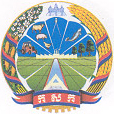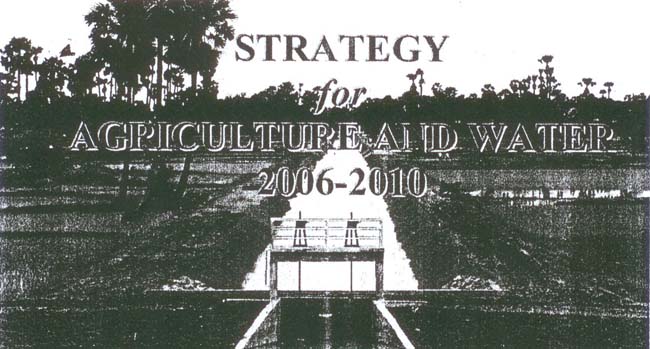|
KINGDOM OF CAMBODIA
Nation Religion King
 |
|
 |
|
Ministry of Agriculture, Forestry and
Fisheries |
|
Ministry of Water Resources and Meteorology |

PREPARED BY
TECHNICAL WORKING GROUP ON AGRICULTURE AND WATER
MARCH 2007, PHNOM PENH
Executive Summary
STRATEGY FOR AGRICULTURE AND WATER
1 Introduction
The Strategy for Agriculture and Water (A&W) is required by the National
Strategic Development Plan 2006-2010 (NSDP). After adoption of the Strategy,
the next step is to prepare detailed programs for implementation.
The
NSDP sets national priorities of alleviating poverty and enhancing economic
growth. A major emphasis is Enhancement of the agricultural sector. A
second major emphasis is Rehabilitation and construction of physical
infrastructure, which includes "management of water resources and
irrigation" as one of its four components1.
2 Policy and institutional environment
The overall policy environment for A&W is set by, in particular, the
National Poverty Reduction Strategy and the National Strategic
Development Plan. The NSDP requires ministries to plan in a sectoral and
coordinated manner. Further, the RGC's Strategic Framework for
Decentralization and Deconcentration Reform promotes a transfer of
responsibilities and resources to sub-national and local levels. Other elements
are support to agriculture and water sector development including the commitment
from all partners, adequate policy and legislation, strengthening of
institutional frameworks of agricultural and water sector, enabling environment
for implementation and empowerment of farmers and rural communities, and
strengthening partnership and ownership.
The
lead RGC agencies in agriculture and water resources are MAFF and MOWRAM
respectively. The Strategy will enable the RGC to mobilize and guide support to
A&W from External Development Partners (EDPs, or "donors"). A&W are especially
important for "grassroots" rural affairs, so important stakeholders are
provincial and sub-provincial administrations, community-based organizations,
NGOs, and the rural households.
3 Strategic analysis
The Strategy for A&W is based on thorough analysis of strengths, weaknesses,
opportunities, and threats. Cambodia's strategic advantages lie principally in
the availability of natural resources and manpower, which at present are under-utilised.
Principal opportunities relate to domestic and export markets for agricultural
products.
4 Vision and goals for Agriculture and Water Resources
The MAFF and MOWRAM Strategic Development Plans for Agriculture and Water
Resources provide the following long term Vision for A& W:
to ensure enough, safe and accessible food and water for all people,
reduce poverty, and contribute to economic growth (GDP per capita), while
ensuring the sustainability of natural resources.
The
Goal for A&W during 2006-2010 is:
to contribute to poverty reduction, food security and economic growth
through (a) enhancing agricultural productivity and diversification and (b)
improving water resources development and management.
The
Goal will be achieved principally by (1) more efficient use and management of
water and land, (2) increased agricultural productivity, and (3) enhanced
agri-business processes. Also needed will be (4) institutional capacity building
and (5) improved access to knowledge and technology. These five areas of work
are defined as programs (see Section 6).
5 The Strategy
There are eight key components of the Strategy.
1. Ensure favourable pre-conditions and build on Strengths/Opportunities
This requires, above all, a strong commitment by the policy
makers, relevant ministries and institutions, as well as by EDPs/donors, to
support the Strategy for A&W. Other aspects of the national environment – as
examples, the RGC's plans to improve governance, strengthen law and order,
strengthening partnership and ownership, integrate Cambodia into
international trade, promote private sector investment – are essential
to a successful Strategy for A&W.
2. Strengthen the enabling environment
The enabling environment for A&W includes relevant policies,
laws/regulations, institutional capacity, etc. Good progress has been made – as
examples, the National Water Resources Policy, several recently approved laws
and sub-decrees in the agriculture and water sector, capacity building in MAFF
and MOWRAM. However, ongoing strengthening is required – as examples,
develop mechanisms to implement policies related to management of land,
water, forest and other resources, enact the draft Law on Water Resources
Management, and develop MAFF and MOWRAM capacities to enforce Laws and
associated sub-decrees that are related to water use, watershed management, land
and other natural resources.
3. Mobilize natural resources: water, land, soil
One of Cambodia's key strengths is the availability of land, soil and water
that at present are not used or are used inefficiently. The Strategy will
include, as examples, promoting improved farm water management
through water harvesting/storage, gravity-fed irrigation systems, and technology
such as drip irrigation of crops; promoting soil fertility management;
protecting water resources from pollution and degradation so that they
continue to be available for fisheries, ecosystem maintenance, etc.; promoting
rice-field fisheries and aquaculture; promoting settlement of cultivable
land and securing land ownership against land theft.
4. Mobilize human and financial resources
Human resources include both RGC officials (at all levels), as well as
farmers and other members of the rural households. Cambodia has a large
workforce which is growing rapidly, but many people are not fully employed and
have limited education or training in useful skills. In addition, many people
have limited access to the money needed to purchase inputs (e.g. fertilizer or
agricultural machinery), maintain facilities (e.g. pumps), or invest in a
business (e.g. a rice mill). Hence, the Strategy must mobilize and make better
use of people and money, including as examples promoting education,
training and extension in A&W, the development of appropriate
technology, more efficient use of skilled people such as
extension workers and engineers, better access to money needed for
investment in the agriculture and water sector, in O&M of irrigation systems,
greater engagement of the private sector in agriculture, water
management & development, and agri-business.
5. Empower people and communities
In addition to mobilizing the workforce (4 above), the Strategy will seek to
empower communities to work together and be more self-reliant. This includes, as
examples, establishing and supporting farmer development , Farmer Water
User Communities, assisting farmers to establish agricultural
cooperatives and other organizations to market agricultural products and
purchase inputs, promoting the availability of micro-credit and other
funding sources to allow people to invest in agricultural production and
agri-business development, and encouraging community organizations
(Commune Councils, Village Development Committees, etc., with access to
Commune-Development Funds) to participate in planning and operation of
community projects for water supply, water management infrastructure, communal
rice drying facilities, etc.
6. Apply a River Basin approach to water and land
Components 3, 4, and 5 must be implemented in an integrated way to obtain
full value. Water resources in most countries are managed within river basins,
and river basins provide a better basis for managing water resources than
administrative boundaries. Hence, the Strategy will promote a river basin
approach to integrated water and land management, to complement
administrative arrangements based on provinces, districts etc.
7. Increase productivity of agriculture
This element of the Strategy aims to increase production, reduce production
costs per unit of output and help to assure product quality. It will help to
achieve increased production of high quality products, thus achieving both food
security and commercial goals. In addition to actions already mentioned in (4)
and (5), elements of the Strategy will include, as examples, improve the
quality of inputs such as seeds and fertilizers; reduce harvesting
and post-harvest losses; introduce innovative agricultural and
water management practices.
8. Extend commercial agriculture
Commercialised agriculture provides the means for rural households and
communities to generate cash income, as well as providing a basis for
agri-businesses. The Strategy will assist farmers to engage in commercial
production by, as examples, providing information and forecasts
regarding market demand; promoting new product opportunities;
establishing value-added processing facilities; administering
arrangements for product quality assurance and food safety;
facilitating entry into profitable markets, particularly via
improved transport and storage facilities, marketing infrastructure,
bulking/wholesaling arrangements, etc
The
eight components can be arranged in a series of four steps which reflects their
sequence in time, and the dependence between them (Figure I.1/4.
1). The diagram can be thought of as like a house: Step 1 is like the
foundations, Step 2 is like the pillars and floor, Step 3 is like the walls, and
Step 4 is like the roof – all leading to the GOAL of (for the house) good
shelter and health for the family and (for A&W) poverty reduction and economic
growth for Cambodia.
The
Strategy components already are – to varying degrees – being implemented. The
sequence of components therefore reflects changes in the relative effort that
should be allocated. At the beginning, more resources should be allocated to the
components earlier in the sequence. This will assure successful implementation
of components that are later in the sequence. As time passes, resources should
be re-allocated towards the later components.
6 Programs
The Strategy will be implemented in five Programs, each with its Development
Goal and several objectives (Figure I.2/4.2). One Program mainly addresses the
enabling environment, two Programs address the "mobilization and empowering"
elements of the Strategy, and two more Programs mainly address the productivity
and commercialization of agriculture. They are:
-
Institutional capacity building and management support program
for agriculture and water resources program
-
Food security support program
-
Agricultural and agri-business (value-chain) support program
-
Water resources, irrigation and land management program
-
Agricultural and water resources research, education and
extension program
The
five programs will contain a set of integrated actions designed to achieve the
development goal and objectives. As a starting point, the programs have been
described as preliminary Terms of Reference for design teams, who will develop
the actions during late 2006. Several EPAs have indicated willingness to provide
the resources for these design teams, and two have started work.
7 Resource requirements
The amount of money that will be required is estimated to be approximately
US$350 million for the five-year period. Other RGC agencies also are engaged in
A&W-related activities, notably rural infrastructure (roads etc.) and land
management. Their budgets for such activity will help to implement the Strategy
for A&W, but at this stage they should not formally be included in the
Strategy's budget. It is likely that this will become more practicable as the
Strategy progressively is implemented, particularly when planning investments
beyond 2010.
8 Monitoring and evaluation
A critical component of strategy and program implementation is to monitor
the results against the targets or indicators. MAFF and MOWRAM will, as lead
agencies, play the principal role in monitoring Strategy implementation for RGC.
"Lessons learned" will help to revise the Strategy for the 2011-2015 period, and
to direct resources towards priority areas. |







